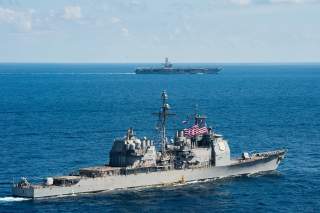China and America Agree: The U.S. Navy is Too Small
Good news for American critics who warn that the U.S. Navy is overstretched.
Good news for American critics who warn that the U.S. Navy is overstretched.
China agrees with you.
Fang Xiaozhi, a researcher at the BRI Institute of Strategy and International Security, at Fudan University in Shanghai, says that the U.S. Navy has too few ships to meet its worldwide commitments. And more important, it doesn’t have enough vessels to defeat China in the Western Pacific.
“Although it possesses the world’s largest naval force, it has to carry out onerous combat and war preparedness missions on the Pacific Ocean, the Indian Ocean, the Atlantic Ocean, the Mediterranean Sea and in the Middle East as its interests are spreading all over the world, and the missions are of complicated and diverse types for that matter,” Fang wrote in China Military Online, an official site of the Chinese armed forces.
“For instance, the U.S. 7th Fleet had constant collisions in the past two years due to excessive missions, which exhausted the front-line officers and soldiers and resulted in poor management. Besides, many American vessels have various malfunctions and a high failure rate because of consistent overwork.”
Fang is echoing American experts who have warned for years that the U.S. Navy is badly overworked and underprepared. Ships are deployed at sea when they should be undergoing maintenance in port, and crews are inadequately trained and overtired, especially in the Pacific fleet. These problems were painfully – and publicly – revealed in 2017, when Navy destroyers collided with merchant ships on two occasions.
In particular, the August 2017 collision of the destroyer USS John S. McCain with a tanker off Singapore, which killed seven Navy sailors, raises questions about the competence in basic seamanship of sailors and their commanders. Investigators found staggering deficiencies in the McCain’s training, morale, leadership and shiphandling skills.
The root of the problem is the Navy is trying to accomplish its Cold War mission of maintaining global presence, but with a far smaller fleet. In 1988, the Navy’s battle force comprised 566 ships. Today, it has shrunk to 290. Even plans to increase naval strength to 326 by 2025, and 355 by the 2050s, would only partially mitigate that shortfall.
Of course, the Chinese military isn’t highlighting these problems because of sympathy for the U.S. Navy. The underlying message is that the U.S. is too weak to defeat in a conflict such as a Chinese invasion of Taiwan. Beijing wants the world to know that while U.S. military and economic power is declining, China’s is growing with the addition of advanced weapons such as aircraft carriers, stealth fighters and hypersonic missiles. And, that America’s democratic, capitalist system is inferior to China’s authoritarian model.
“The U.S. Navy will face challenges both internally and externally due to a wide range of factors, such as the implementation of America’s national strategy, the tolerance of ‘America first’ by its allies and partners, the impact on U.S naval construction imposed by domestic reform in terms of public support and capital, and the struggle for resources by different military services,” Fang writes. “All these will probably undermine the global superiority of the U.S. navy.”
“Moreover, it stubbornly sticks to the hegemony mindset and is used to throwing its weight around on the oceans and expanding its maritime hegemony without restraint, which is sure to court more thorny issues in the future, thus further sharpening the contradiction between maintaining national hegemony and declining national strength.”
In other words, America should stay out of China’s way.
Michael Peck is a contributing writer for the National Interest. He can be found on Twitter and Facebook.

